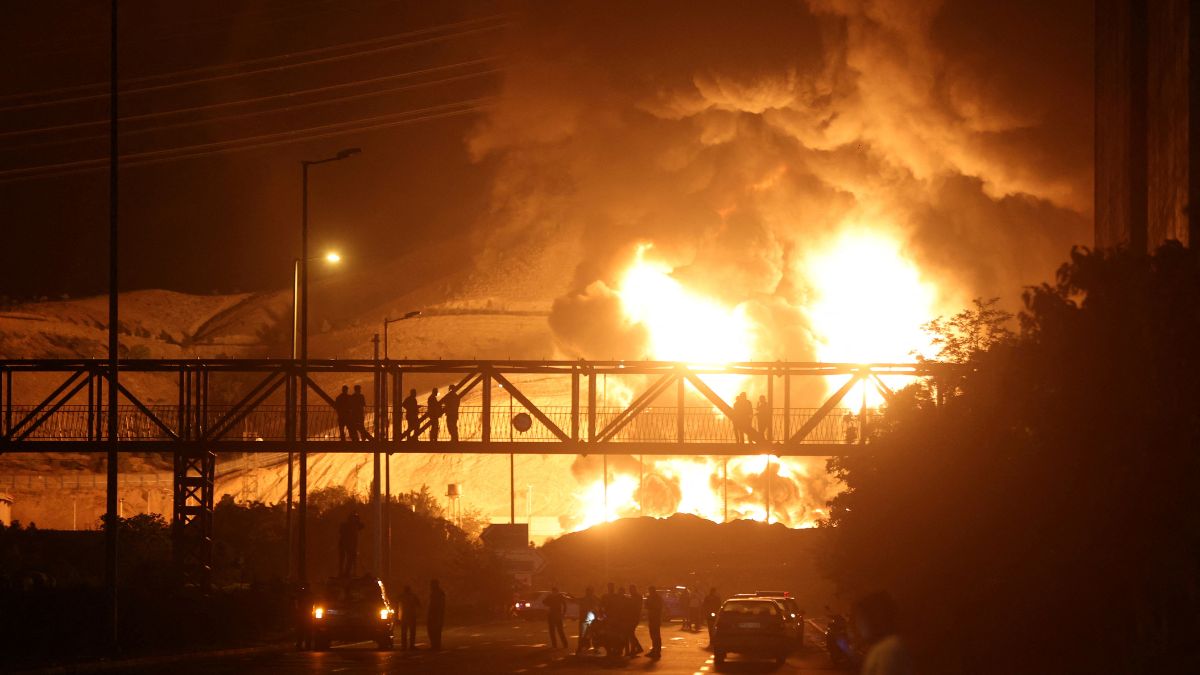As tensions between Israel and Iran intensified over the weekend, global financial markets responded with sharp volatility, sending investors scrambling for safety. The conflict, which has now escalated into direct military strikes, has heightened geopolitical risk and stoked fears of stagflation — a toxic mix of stagnant growth and rising inflation.
Surge in oil prices and flight to safe havens
One of the most immediate and visible effects of the Israel-Iran escalation was a surge in crude oil prices. Reports say Brent crude jumped 5.5 per cent in early trading on Monday, though it quickly pared gains to under 1 per cent later in the day. On Sunday, Brent futures surged by nearly 4 per cent, trading close to $76.94, following a 7 per cent rise on Friday, the largest single-day gain since the onset of the Russia-Ukraine war in 2022.
West Texas Intermediate (WTI) crude also rose by $4.94, or 7.26 per cent, closing at $72.98 per barrel on Friday. Earlier, it had surged over 14 per cent, reaching its highest level since January 2025. This upward momentum continued as markets opened on Sunday evening.
The spike in oil prices was accompanied by a corresponding rise in gold and the US dollar, traditional safe-haven assets during times of global uncertainty. Gold approached near-record highs, while the dollar strengthened, drawing in capital from riskier assets. Kathryn Rooney Vera of StoneX Group noted that the market is “headline-driven and short-term focused,” emphasising the volatility and rapid shifts in investor sentiment.
Market selloff reflects regional anxiety
While oil and safe-haven assets gained, equity markets in the region suffered. West Asian stock markets fell amid the chaos and analysts warned that global markets were likely to follow suit. The Dow Jones Industrial Average dropped 769 points, or 1.8 per cent, while the S&P 500 fell over 1 per cent and the Nasdaq lost 1.3 per cent. US futures also opened marginally lower on Sunday night.
Meanwhile, European equity futures edged downwards and Chinese stocks swung between gains and losses on Monday. However, some Asian markets displayed surprising resilience. Japan’s Nikkei 225 gained 1.1 per cent, buoyed by a rally in defence stocks as Japan and the EU discussed deeper defence industry cooperation.
Despite these localised gains, the general sentiment was one of caution and unease. Tim Waterer, chief market analyst at KCM Trade, remarked that markets were showing “a surprisingly brave face” given the uncertain trajectory of the conflict.
Strait of Hormuz in focus: A chokepoint for global oil
At the heart of global energy market anxiety is the Strait of Hormuz, a narrow waterway between Iran and Oman through which roughly 20 per cent of the world’s oil flows. A potential closure or disruption of this strategic corridor would send shockwaves through oil markets.
Rooney Vera of StoneX expressed concern over the possibility of the Strait being closed due to military action or retaliation, warning that such a scenario “could worsen inflationary pressures” globally. Although Iran’s oil export facilities had not been directly hit by Israeli strikes, images of a massive blaze at a Tehran fuel depot only heightened these fears.
Eric Beyrich, a portfolio manager at Sound Income Strategies, highlighted that while the attacks had not yet damaged Iran’s oil infrastructure, the situation was fluid and could change quickly. Any escalation that endangers the free flow of oil could prompt prices to spike to triple digits, adding further stress to an already fragile global economy.
Escalating geopolitical risk and the threat of stagflation
With energy prices rising sharply and economic growth slowing in several regions, analysts have raised the spectre of stagflation. This concern mirrors the economic conditions of the 1970s, when oil shocks contributed to prolonged inflation and weak growth.
Jim Carroll of Ballast Rock Private Wealth told Bloomberg that “it’s more of an oil story than an equity story at this point,” suggesting that the implications of the conflict could manifest most strongly through inflation rather than immediate financial market collapse. But inflation has a way of seeping into all corners of the economy. Higher oil prices increase costs for transportation, manufacturing, and food, which in turn erode consumer purchasing power.
Analysts fear that central banks could find themselves in a bind. On one hand, they may want to lower interest rates to support slowing economies. On the other, rising energy costs risk reigniting inflation, potentially forcing monetary authorities to delay or reverse any planned rate cuts. The Federal Reserve, Bank of Japan and other major central banks are set to announce interest rate decisions this week, adding further uncertainty.
Historical echoes: Lessons from the Russia-Ukraine war
The recent conflict has reignited memories of the oil market shock following Russia’s invasion of Ukraine in February 2022. That conflict pushed Brent crude to over $139 per barrel and WTI to $133, according to historical data cited in multiple analyses. The war caused Brent to surge by 56.33 per cent and WTI by 52.33 per cent, fundamentally altering the volatility landscape of crude markets.
A 2023 study using multiresolution causality testing found that the Russia–Ukraine war accounted for over 70 per cent of oil price fluctuations during its peak impact period. Similar dynamics may be in play with the Israel-Iran conflict, though so far, the oil market response has been more tempered.
Rahul Kalantri, Vice President of Commodities at Mehta Equities, noted that “the recent sharp rally and heightened volatility” due to the Israel-Iran conflict warrant a cautious trading approach. He identified $74.80 as a key resistance level for WTI, suggesting that the current price spikes could persist if geopolitical instability continues.
Investors struggle to price in risk
As markets try to absorb the implications of the widening conflict, many investors remain unsure of how to position themselves. Bond markets offered mixed signals, with yields on US Treasuries and Asian government bonds rising, suggesting that investors were not yet fully embracing risk-off strategies.
However, the Cboe Volatility Index (VIX), often referred to as Wall Street’s “fear gauge,” closed at 20.82 on Friday — its highest level in three weeks — indicating a growing sense of unease among traders. Although Israeli assets initially took a hit, the shekel rebounded by more than one per cent against the dollar after several days of losses.
Jack Ablin, Chief Investment Officer at Cresset Capital, pointed out that some investors were relieved that Iran’s military response had not been as robust as feared. “The equity market will breathe somewhat of a sigh of relief,” he said, though he also cautioned that the situation remains unpredictable.
Broader global impacts: From energy security to inflation policy
The global economy was already grappling with slow growth and uneven recovery. The conflict in West Asia threatens to further destabilise trade flows, particularly energy supply chains. Disruptions or even perceived threats to oil exports from the Gulf region can tighten supply and raise shipping costs due to increased insurance premiums and rerouting.
In Europe and Asia, governments are likely to reassess their energy strategies. China has already signalled interest in diversifying supply routes and expanding strategic oil reserves. Meanwhile, the US may consider tapping its own Strategic Petroleum Reserve to mitigate price spikes, though such moves offer only temporary relief.
For energy-importing nations, this latest crisis serves as a reminder of the need to diversify away from geopolitical chokepoints. Longer-term solutions may involve increased investment in renewables, more robust storage capacity and international coordination on emergency reserves.
Volatility set to continue amid unresolved conflicts
With both the Israel-Iran confrontation and the ongoing war in Ukraine showing no sign of resolution, markets are expected to remain volatile. Investors are likely to continue shifting between risk-on and risk-off modes, depending on developments on the ground and central bank signals.
Analysts are divided on how long the current oil price rally will last. Norbert Rücker of Julius Baer emphasised that the oil market today is far more resilient, with ample global storage and growing exports from outside West Asia. However, he conceded that oil “is the fever measure” of such conflicts, often reacting faster and more strongly than other indicators.
In the meantime, central banks will need to tread carefully. A premature rate cut could risk reigniting inflation, while holding rates too high for too long could stall growth, particularly in emerging economies already dealing with debt stress and slowing demand.
A world on edge
The latest escalation between Israel and Iran has once again exposed the fragility of global markets in the face of geopolitical upheaval. While the oil markets have not reached crisis levels seen during the Russia-Ukraine war, the risk premium is clearly back, with investors bracing for further shocks.
The conflict highlights the interconnectedness of global financial systems, where a regional flare-up can ripple through commodity markets, monetary policy decisions, and consumer prices worldwide. Whether the world is on the brink of another oil crisis or merely witnessing a temporary spike, one thing is clear: the days of energy market stability are behind us—at least for now.


)
)
)
)
)
)
)
)
)



